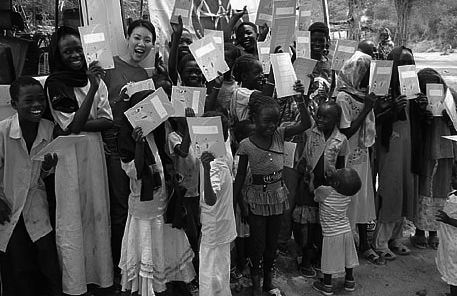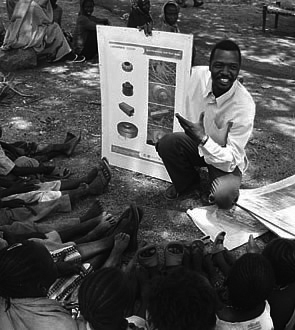Japan's Official Development Assistance White Paper 2009
Column 12 Safety through Innovation
— Mine Risk Education (MRE) in South Kordofan State, the Sudan —
While the 22-year civil war in the Sudan ended in 2005, people of the Sudan continue to live with the threat of many unexploded mines and bombs still present in the country. Since the end of the civil war, many refugees and displaced persons have returned home, and it is expected that another approximately 7,000 people will return to the South Kordofan State in the central part of the Sudan. Those who have been away from home for a long period of time lack information on the locations of mines and combat area, putting them at high risk for injury from unexploded mines and bombs. Furthermore, there is the risk that children in particular may injure themselves by accidentally touching explosives they come across when playing in the mountainous areas where mines and unexploded bombs remain.
Since November 2005, the Association for Aid and Relief, Japan (AAR Japan) has been collaborating with the United Nations Mine Action Service (UNMAS). In conducting mine risk education (MRE) in order to prevent the people of the Sudan from suffering further injuries. Since August 2006, members of AAR Japan have visited villages and repatriation centers for refugees to carry out MRE in the South Kordofan State, the region with the second largest amount of mines and unexploded ordnance in the Sudan*1.
The representative of AAR Japan in the Sudan, Ms.Yuki Daizumoto, reflects back on the beginning of the organization's activities, saying "When AAR Japan first entered the Sudan, we didn't really have appropriate teaching materials for the local needs. We found that we needed to create simple posters and brochures that used drawings and pictures to explain the message." The brochure on land mines which Ms. Daizumoto and her AAR Japan colleagues created has been highly praised by the Sudanese. AAR Japan has printed 462,000 copies of the brochure and has distributed them not only within the Sudan but also to refugee camps in neighboring countries.
Ignorance, misunderstanding and mistakes can be fatal in the areas where many dangerous explosive ordnance still remain. AAR Japan tries to use innovative methods to imprint this message on the minds of the Sudanese. Overseas representative Ryo Yamaura comments, "We teach risk avoidance by using posters and kamishibai (a traditional form of Japanese art of story-telling with picture cards). We try to explain in easy-to-understand ways the shapes of mines and the areas where they are buried. The drawings and pictures really help in explaining how to avoid buried explosives." AAR Japan also gives notebooks to children so they can study what mines and unexploded bombs look like. This homework saves children and helps spread information among families. The prevention of further casualties from mines can only be achieved through tenacious educational activities. AAR Japan is carrying out a wide range of actions on this issue.
AAR Japan emphasizes the importance of self-help effort by the Sudanese themselves. And while working with local NGOs, it intends to hand over the MRE to local people gradually. Ms. Daizumoto comments, "It will take many years until the Sudan is completely mine-free. Until then, the people here must learn to live with the danger by mines and unexploded bombs. We need to foster the capacity of local NGOs which can help support the livelihoods of the Sudanese."
*1 The number of beneficiaries of AAR Japan's work as of June 2009 was 33,805 people.

Ms. Daizumoto with Sudanese children (Photo: Association for Aid and Relief, Japan)

A Sudanese instructor explains landmines (Photo: Association for Aid and Relief, Japan)

